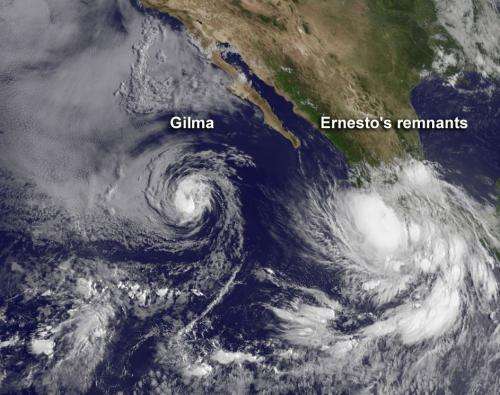NASA sees two tropical cyclones in Eastern Pacific

The Atlantic Ocean hurricane season is in full swing and the Eastern Pacific seems like it's trying to catch up. On August 10, NOAA's GOES-15 satellite captured Tropical Storm Gilma and a low pressure area that was once the Atlantic Basin's Tropical storm Ernesto, now moving off the western Mexican coast.
NASA's GOES Project, located at NASA Goddard Space Flight Center in Greenbelt, Md. has been busy creating images and animations of Tropical Storm Gilma and the remnants of Tropical Storm Ernesto as it crosses Mexico from the Gulf of Mexico and has begun its entrance into the Eastern Pacific Ocean.
NASA's GOES Project uses data from NOAA's Geostationary Operational Environmental Satellites (GOES), and the GOES-15 satellite covers the Eastern Pacific Ocean basin and the eastern U.S. from a fixed orbit. GOES-15 provides continuous data that NASA makes into images and animations. An image captured on August 10, 2012 at 1500 UTC (11:00 a.m. EDT) shows Ernesto's clouds lingering over the western coast of Mexico and Gilma out over open waters.
At 11 a.m. EDT on August 10, Tropical Storm Gilma's maximum sustained winds were near 65 mph (100 kmh). The National Hurricane Center (NHC) expects Gilma to weaken over the next two days because of an increase in vertical wind shear and movement into cooler waters. The National Hurricane Center expects Gilma to become a tropical depression sometime on August 11. Gilma was centered about 670 miles (1,080 km) west-southwest of the southern tip of Baja California near latitude 18.8 north and longitude 119.3 west. Gilma is moving toward the north-northwest near 5 mph (7 kmh) and is motion is expected to continue over the next day or so.
Behind Gilma, and located along the southern coast of Mexico is a large area of showers and thunderstorms associated with the broad circulation of weakening tropical depression Ernesto. Because environmental conditions are favorable, the low, formerly known as Ernesto, has a 60 percent chance of developing into a tropical depression is it moves westward and into the open waters of the Eastern Pacific Ocean. Once it becomes a tropical depression and if it strengthens to a tropical storm, it would get a new name.
Provided by NASA's Goddard Space Flight Center




















